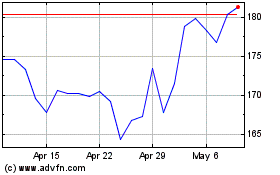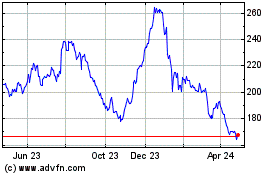European Regulator OK's 737 Max Return But Distances Itself From FAA
January 27 2021 - 5:58PM
Dow Jones News
By Andy Pasztor
Boeing Co. and some of its airline customers got an immediate
boost from Wednesday's ungrounding of 737 MAX jets across Europe,
but the move also portends more-stringent safety reviews of future
U.S. aircraft by the region's aviation regulator.
The long-awaited decision formally allowing the resumption of
commercial 737 MAX operations in Europe followed pledges from the
head of the European Union Aviation Safety Agency to maintain
greater independence from the U.S. in certifying Boeing's
long-range 777X and other new aircraft models.
As part of that tougher stance, Patrick Ky, EASA's executive
director, emphasized that permitting 737 MAX flights was based on
the agency's assessment "carried out in full independence of Boeing
or the Federal Aviation Administration."
Mr. Ky had previously endorsed the hardware, software and
pilot-training fixes affecting the MAX fleet, which were devised
and tested with European collaboration. But on Wednesday and the
days leading up to the announcement, Mr. Ky repeatedly emphasized
that EASA performed its own tests and analyses-and would continue
to follow the same pattern for other aircraft types in the
future.
The agency reassessed 737 MAX systems beyond the automated
flight-control feature that caused two crashes and took 346 lives
before the planes were grounded world-wide in March 2019. The FAA
lifted its grounding order in November and Canadian regulators
followed earlier this month. Boeing expects the 737 MAX fleet to be
flying in every region by the summer.
Looking ahead to certifying other models, though, Mr. Ky has
publicly laid out new procedures and hurdles. He has promised
European lawmakers that his agency will rely less on FAA expertise
or U.S. safety assessments--and conduct more of its own independent
analyses--before signing off on future aircraft.
That's a break from past practice and, according to industry
officials, has contributed to the delay in introduction of the 777X
that Boeing announced Wednesday. EASA's tougher scrutiny also is
expected to apply to airliners from other manufacturers outside
Europe, as well as business jets built in the U.S.
Before the 737 MAX crisis, both EASA and the FAA were jointly
pursuing a different course. They focused on forging ways to
increase reliance on each other's safety approvals, in order to
reduce workload and avoid duplication. At annual safety
conferences, much of the discussion centered around further
reducing the number of aircraft systems or features that would
require detailed checking and vetting by both agencies.
That no longer is a European priority. In testimony to European
lawmakers on Monday, Mr. Ky didn't single out the 777X. But his
comments about independent European safety verification of future
models pointedly revealed the extent of the public divide that has
separated air-safety regulators on opposite sides of the
Atlantic.
FAA chief Steve Dickson has said that international efforts to
eliminate 737 MAX safety problems ended up improving coordination
between international regulators and, in some ways, enhanced trust
among them. In the process, he also has disputed widespread
assertions by industry officials, foreign regulators and outside
safety experts that the FAA's global reputation for safety
leadership has eroded.
But Mr. Dickson, who has told associates he wants to remain in
his job under the Biden administration, also has talked about the
importance of humility in some of his recent media and industry
appearances. It is important to recognize that "no one individual,
no one organization, can know everything all the time," he told a
virtual industry gathering late last year, promising to work
closely with foreign counterparts.
Seeking to reassure a committee of the European Parliament about
EASA's independence in the wake of the 737 MAX tragedies, Mr. Ky on
Monday testified that his agency was committed to enhanced
oversight of new models. After years of increased reliance on FAA
oversight of Boeing's evolving technical and design changes, Mr. Ky
said EASA plans to step up its own engineering reviews. The agency
also intends to shift more attention and resources to understand
so-called "human factors" issues, which explain pilot interactions
with automated systems and predict how swiftly average pilots will
respond to cockpit emergencies. Boeing has acknowledged its
mistaken assumptions about how pilot reaction time played a major
role in the 737 MAX's faulty design.
In addition, after months of discussion Mr. Ky's team persuaded
Boeing and the FAA's leadership to work with EASA, once the MAX
fleet returns to European skies, to add an extra computerized
safety system designed for more redundancy to help pilots determine
airspeed and other flight characteristics.
Write to Andy Pasztor at andy.pasztor@wsj.com
(END) Dow Jones Newswires
January 27, 2021 17:43 ET (22:43 GMT)
Copyright (c) 2021 Dow Jones & Company, Inc.
Boeing (NYSE:BA)
Historical Stock Chart
From Mar 2024 to Apr 2024

Boeing (NYSE:BA)
Historical Stock Chart
From Apr 2023 to Apr 2024
